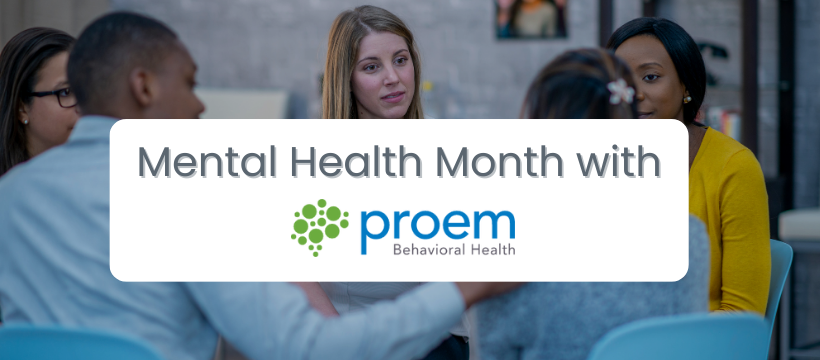May is Mental Health Month, and it’s a reminder that every day, people are struggling with an array of mental health issues such as depression, anxiety, and trauma.
Consider that one in five adults in the United States experiences some form of mental illness in a given year and less than half of those ever receive the care needed. This is why it’s important to increase conversations around mental health in order to raise awareness and facilitate treatment.
Proem Behavioral Health is a thought leader on mental health and a provider of digital tools to help healthcare professionals assess, treat, and deliver better outcomes for patients with mental illness. We recently talked to John Letter, CEO of Proem, about the importance of mental health awareness.
Welcome, John. What is the current state of mental health in our country? Is it becoming more or less stigmatized?
JL: Mental illness is becoming less stigmatized—you could say it’s increasingly becoming okay to not be okay—and I think that’s largely due to growing awareness and acceptance. At the same time, we’re also recognizing that much more still needs to be done.
Our uninsured or underinsured often wind up in ERs when they’re actually in a behavioral health crisis, for example. To use a comparison, for better outcomes, we’ve got to support the patient before they become diabetic, while they’re still in the pre-diabetic phase. For someone experiencing mental illness, that means catching the problem earlier and educating the public about what things to look out for in friends, family, and co-workers when it comes to mental illness.
We also need tools that can be used in healthcare settings to conduct standard mental-health screenings—as part of annual wellness visits, for example—since so many of those struggling never wind up at a psychologist or psychiatrist’s office for assessment. What I mean is that we need to work to triage people to the right level of care, earlier, before it becomes a crisis.
Why are those in need of mental health services so often falling between the cracks?
JL: Greater access to care, particularly in underprivileged or rural communities where such access doesn’t exist, is needed. Federally qualified behavioral health centers are a huge step in the right direction, but I think as part of this we also need to focus more on our youth.
If you can catch mental-health issues earlier, you’re avoiding not only human suffering but costs to the system. There’s a clog in our current pipes because people have been ping-ponged to various providers and facilities, they’ve been misdiagnosed over and over again—so they’re going to stay in the system because they aren’t getting the proper care.
What can we do to create greater parity between physical and mental healthcare?
JL: That’s a complex question, but I’ll try to give my perspective. As an example, when someone goes to a doctor with a physical problem, and the doctor believes the diagnosis requires an MRI, it gets passed through as a medical necessity, typically no questions asked since there’re signs there’s a torn ACL or whatever. Those signs are proof an MRI is needed to determine next steps.
This same fluidity needs to happen in behavioral health treatment. Payers are saying, hey, I understand that you want to be reimbursed for this but show me proof. The reality is that there are no MRIs in behavioral health. So what we have instead are posed questions and conversations with patients based on what science currently knows about behavioral health. It’s not as clear-cut as a physical ailment, so it’s a very complex thing. To better bridge the gap in covering mental health costs, we need to start with consistent data that is quantifiable and qualifiable for making treatment decisions.
What can healthcare workers on the front lines, such as family physicians and ER doctors, do to better identify and help patients with mental illness?
JL: Front-line workers are already overworked, so having time to also consider the patient’s mental health is a challenge. What we’re missing is that if we can provide the right screening tools for these clinicians, it isn’t such a burden. They can more quickly and accurately identify a depressive patient, for instance, and triage them in the system to the right behavioral health professional for treatment.
This is where Proem Health’s assessment and diagnostic tools come in. They deliver faster and more accurate identification of mental health problems and are part of a collaborative care model to ensure the whole person is being treated for optimal wellness.
This is Mental Health Month. What is the key takeaway for our readers?
JL: While Mental Health Month shines a spotlight on awareness, mental illness doesn’t manifest itself only in May. We need to make mental-health awareness a continual part of the fabric of our society, much in the same way as we’ve done for physical health.
For a long time, we’ve talked about the importance of eating right, exercising, and sleeping well. Mental health awareness and treatment need to be given equal and ongoing consideration—a fourth leg of the stool in terms of what constitutes a healthy person and makes our lives better.
_________________________________________________________________
Continue reading more of our recent blog posts

